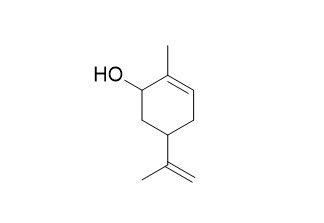(-)-Carveol
Reference standards.
Inquire / Order:
manager@chemfaces.com
Technical Inquiries:
service@chemfaces.com
Tel:
+86-27-84237783
Fax:
+86-27-84254680
Address:
1 Building, No. 83, CheCheng Rd., Wuhan Economic and Technological Development Zone, Wuhan, Hubei 430056, PRC
Providing storage is as stated on the product vial and the vial is kept tightly sealed, the product can be stored for up to
24 months(2-8C).
Wherever possible, you should prepare and use solutions on the same day. However, if you need to make up stock solutions in advance, we recommend that you store the solution as aliquots in tightly sealed vials at -20C. Generally, these will be useable for up to two weeks. Before use, and prior to opening the vial we recommend that you allow your product to equilibrate to room temperature for at least 1 hour.
Need more advice on solubility, usage and handling? Please email to: service@chemfaces.com
The packaging of the product may have turned upside down during transportation, resulting in the natural compounds adhering to the neck or cap of the vial. take the vial out of its packaging and gently shake to let the compounds fall to the bottom of the vial. for liquid products, centrifuge at 200-500 RPM to gather the liquid at the bottom of the vial. try to avoid loss or contamination during handling.
Primary and Industrial.2018, 52(11)
The Journal of Animal & Plant Sciences.2020, 30(6):1366-1373
J Ginseng Res.2023, 47(4):572-582.
Plos One.2020, 10.1371
Drug Des Devel Ther.2020, 14:5189-5204.
Acta Chromatographica2021, 00960.
Appl. Sci. 2024, 14(13), 5815
Int J Nanomedicine.2022, 17:6513-6525.
Russian J Bioorganic Chemistry 2021, 47:1411-1417.
Pharmaceuticals (Basel).2024, 17(8):988.
Related and Featured Products
Atmospheric environment, 2005, 39(40):7715-7730.
Gas-phase ozonolysis of the monoterpenoids (S)-(+)-carvone, (R)-(−)-carvone, (−)-carveol, geraniol and citral.[Reference:
WebLink]
Biogenic emissions of volatile organic compounds (VOCs) play a fundamental role in atmospheric chemistry. Vegetation is the most abundant natural source of VOCs, while terpenoids, as limonene, alpha and beta pinene and mircene, top the plants emission list.
METHODS AND RESULTS:
Much interest has been demonstrated in oxidation and photooxidation reactions of VOCs, particularly of monoterpenoids, owing to their diversity and to uncertainties regarding their mechanism of reaction. Quantification of primary carbonylic compounds, as well as of biradical reaction components, is highly relevant to the understanding of the major reactions. In this context, taking into account both structural factors and the fact that these compounds are found in the essential oils of plants typically found in Brazil and that they may be present in the atmosphere from emission by the plants, the monoterpenoids (S)-(+)-carvone, (R)-(-)-carvone, (-)-Carveol, geraniol and citral (a mixture of the isomers geranial and neral) were selected for this study. The ozonolysis reactions of the monoterpenoids were carried out under dark conditions for all experiments, due to their photochemical reactivity.
CONCLUSIONS:
The analysis of the results lets us propose a mechanism by which these reactions occur. The observed results of the ozonolysis of S and R carvone suggest that the stereochemistry of asymmetric carbon does not affect either in the yields of both formaldehyde and of OH radicals produced in the reaction, or in the reactivity of these compounds, for which the rate constants were in the scale of 10(-6) s(-1). We found that, in the (-)-Carveol's cis and trans mixture, even though the hydroxyl in the axial position-in the case of trans-.



